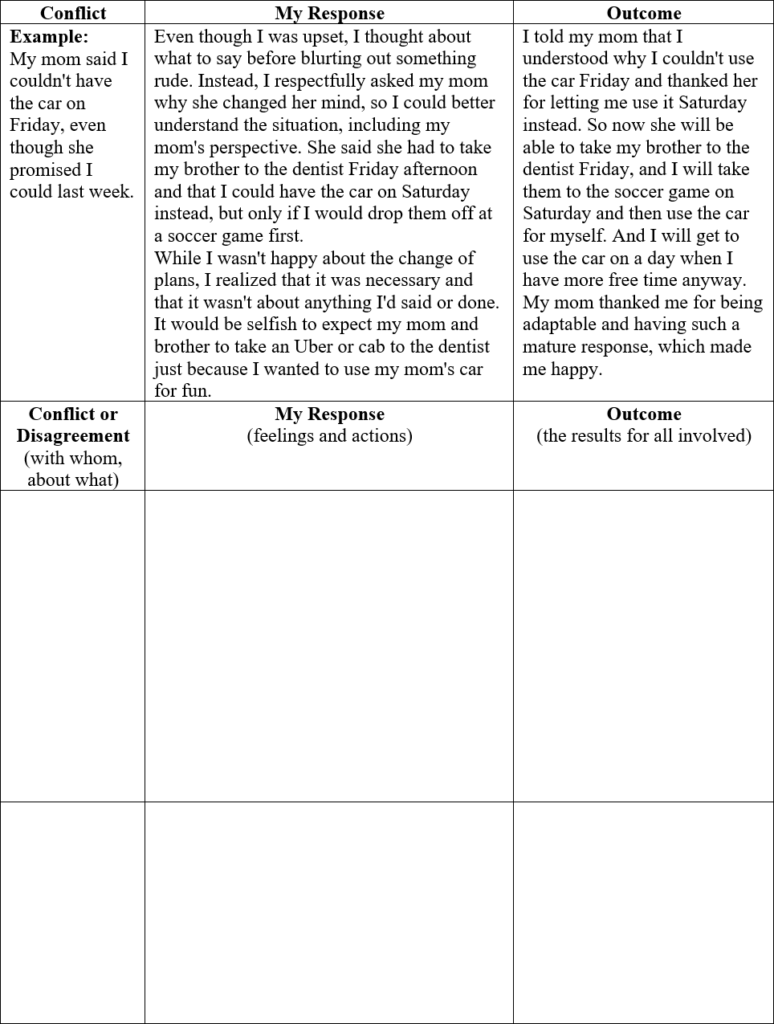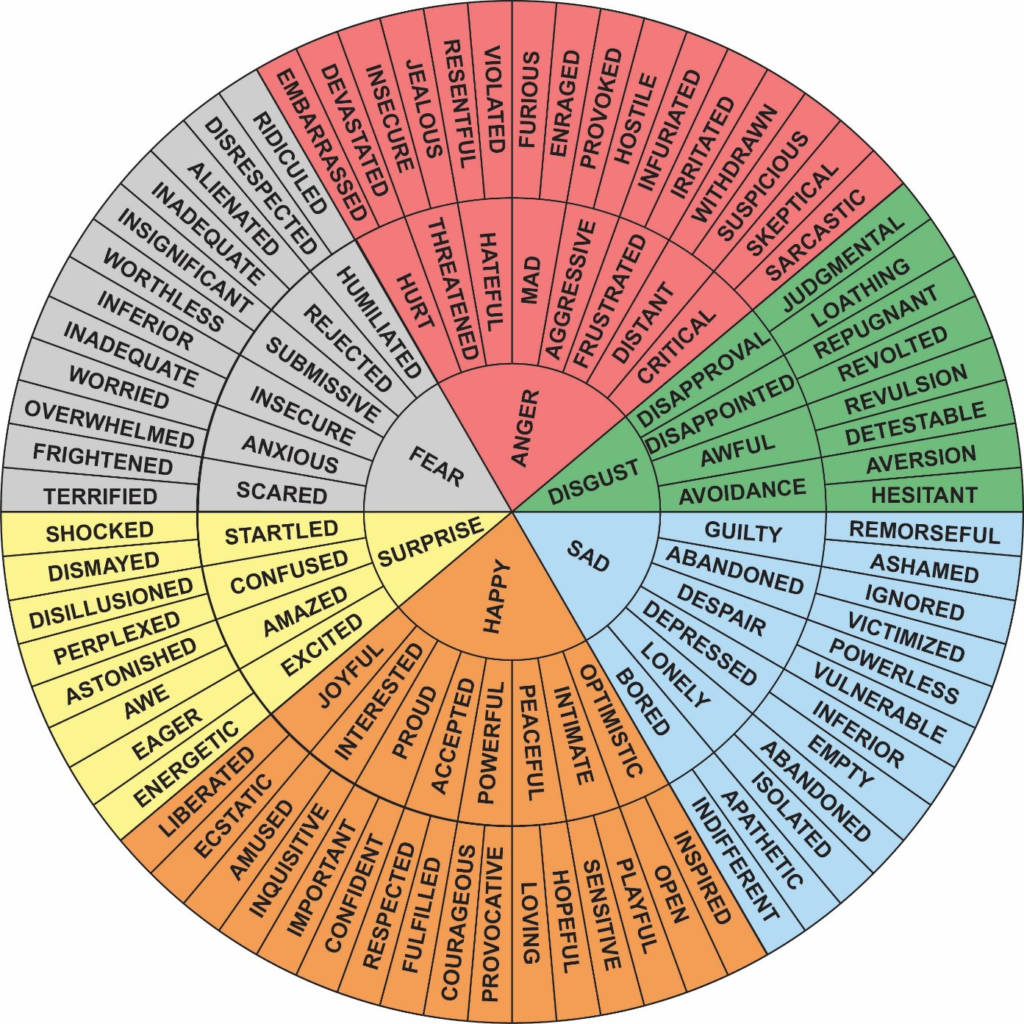Part 1: Teaching Students What Conflict Management Is and Why It Is Important
Part 2: Understanding Your Ability to Manage Conflicts
- Teach Students: 2a. Summarizing My Current Ability to Manage Conflict
- The Conflict Management Knowledge Test
- Creating an Account to Administer the Conflict Management Knowledge Test
- Teach Students: 2b. How Does My Response to Conflict Affect the Outcome?
Part 3: Understanding Your Usual Response to Conflict
Part 4: Embedding Opportunities for Students to Practice Conflict Management
Part 5: The College and Career Competency Framework
Part 2: Understanding Your Ability to Manage Conflicts
Learning Target: Students can identify their strengths and challenges in managing conflict.
Part 2 will explore activities that help students better understand how they currently manage conflicts and determine areas for growth. In Teach Students: 2a. Summarizing My Current Ability to Manage Conflict, you will help students reflect on how well they currently manage conflict, and prepare them for taking the Conflict Management Knowledge Test. The Conflict Management Knowledge Test helps students identify which areas of managing conflict are their strengths and which areas they find more challenging.
Teach Students: 2a. Summarizing My Current Ability to Manage Conflict
Before administering the Conflict Management Knowledge Test, prompt students to think about recent interactions with others and their ability to manage any conflict or disagreement that occurred. Next, ask students to reflect on the following questions and then write a summary sentence for each question on the Teach Students: 2a. Summarizing My Current Ability to Manage Conflict handout (Handout 2a. linked to on page 11 of the Educator Workbook):
- Describe a time when you wished you had approached conflict differently.
- In the last conflict you experienced, were you able to understand the other person’s perspective? Why or why not?
- Describe a time when your efforts to resolve a conflict or disagreement didn’t go well or when have you simply avoided the issue.
Ask students to think about their answers, then use the questions below to support reflection on which areas of conflict management might be a strength for them and which areas might be more challenging. Ask students to write their responses on the handout.
- Do you feel that you typically stop and consider the reasons behind conflicts when you are experiencing tension or disagreeing with another person?
- How well are you able to pause and try to understand the perspectives of all people involved in the conflict?
- Describe some strategies you currently use to manage or resolve conflicts with others.
Explain to students that they will each be taking the Conflict Management Knowledge Test to understand better how well they are currently able to manage and resolve tension, disagreements, and conflict. Instruct them that this survey will not be used as a grade, but you want them to be reflective and honest because they will use this information to think about their strengths and areas for growth.
Tell students that as they read each item on the questionnaire, they should pause to think about how well they managed conflicts in that area over the last couple of months, especially when it was difficult.
2a. Reflect and Apply: Think about conflicts you have helped resolve between students.
- How often do you start by identifying the reason for the conflict? Summarize the sorts of questions you ask your students when identifying the reason for the conflict.
- How do you help your students identify the different perspectives of everyone involved in the conflict?
- How often do you suggest alternative strategies for managing their conflicts, such as talking things through before reacting or walking away from the situation instead of responding to it? Is there a particular strategy that you frequently recommend?
- How will you respond differently the next time you have to help students resolve a conflict now that you know more about conflict management?
Use page 6 of the Educator Workbook to record your responses.
The Conflict Management Knowledge Test
The Conflict Management Knowledge Test (Gaumer Erickson, & Noonan, 2021a) is written at a fifth-grade reading level, and accommodations can include reading the items aloud or explaining the items. It is divided into three sections. The Questionnaire section (Items 1–21) has students rate themselves on a scale from not like me to very like me for each conflict management behavior/attitude described; there are no right or wrong answers in this section. Each item fits within one of the components, and students’ responses in this section are automatically compiled to show which component is their area of strength and which component is more challenging for them. The Knowledge Test section (Items 22–45) assesses students’ knowledge of conflict management concepts with true/false and multiple-choice items. There are correct answers for each of these items, and they are automatically scored when the survey is submitted. Finally, the Essay (short answer) section (Item 46) asks students to respond to a scenario and will need to be scored by a teacher.
The questionnaire helps students recognize which conflict management components are areas of strength and which components are more of a challenge. The knowledge assessment can determine their knowledge of conflict management concepts, which is often more limited than students anticipate. This awareness can help with gaining student buy-in for learning. For more information on utilizing the Conflict Management Knowledge Test to measure students’ growth in conflict management, see the Conflict Management Assessment Suite: Technical Report (Gaumer Erickson & Noonan, 2022).
Creating an Account to Administer the Conflict Management Knowledge Test
To administer the Conflict Management Knowledge Test to students, educators create an account on https://www.cccstudent.org/, a free assessment site (students do not need accounts). Once you have given the Conflict Management Knowledge Test, you can view and analyze classroom and individual student results on this site. The assessment results can be used to help refine instruction, and students and educators can use the results to show growth in knowledge of conflict management. Additional details for launching an assessment and reviewing the results are provided on the website.
Now that students have a better understanding of their current ability to manage conflict, they are ready to start thinking about how their responses affect the outcome of a situation. We respond to conflicts based on how we perceive the situation, not necessarily objectively.
In Teach Students: 2b. How Does My Response to Conflict Affect the Outcome, you will help raise students’ awareness of how their responses to conflict may be affecting the outcome and, ultimately, their relationships with others. Once students are aware of their typical reaction to tension, disagreements, and conflict, they can reflect and consider how this may not lead to a productive resolution.
Teach Students: 2b. How Does My Response to Conflict Affect the Outcome?
Explain to students that there are many different responses to conflict and that each response is appropriate depending on the situation. Explain that our reactions to clashes with others are usually based on our perception of the conflict, which may or may not be accurate. Just because you feel a certain way doesn’t mean everyone involved is experiencing the same thing. How we perceive a situation is likely different than how others do, especially during a disagreement.
Tell students that they will track their responses to conflict and the resulting outcomes in the Teach Students: 2b. How Does My Response to Conflict Affect the Outcome? handout (Handout 2b. linked to on page 11 of the Educator Workbook). Ask students to write down three conflicts they encounter with friends, family members, or even teachers over the next few days. For each conflict, they will include a detailed description, how they reacted or responded, and what happened—or the outcome. This record will help them better understand how their responses to various conflicts affect the situation’s outcome.
Read through the first example with students, noting how the description of My Response contains details about the situation such as how the person involved was feeling—or emotions—as well as their actions—or what they did. The outcome includes details about how each person involved responded. Tell students that they will need to include similar details in their collected examples. Identify a clear due date for the completed log, such as one week away.

After the due date, arrange students in small groups to discuss the examples of conflict they recorded. As they are sharing their experiences with the group, ask them to use these guiding questions to help generate a meaningful discussion:
- Did anyone have conflicts with an adult? What was the cause of the conflict with an adult?
- Did anyone have conflicts with a sibling or friend? What was the cause of the conflict with a sibling or friend?
- In your examples, were there times when your feelings and actions became overwhelming, and you responded in a way that you regret? If so, explain.
- Did each conflict result in a productive outcome? If not, brainstorm what you might have done or said differently to achieve a better result.
Listen to a fellow educator recount a story of conflict from when she was of a similar age to your students, her response, and the outcome.
2b. Reflect and Apply: Many of your students may find it challenging to identify their underlying feelings in a situation. For example, students may say that they are angry in a situation, but when they stop and think about why they were feeling angry, they might realize that the emotion is more complex, such as jealousy or embarrassment.
The Feeling Words Wheel (Thinkmap, 1998) can support students in identifying their emotions. Students can start with the base emotion in the middle ring, then use the outer rings to identify more complex emotions. When we don’t accept and recognize our emotions, it can create bias in judgments, insecurities, and reduced control over our behavior. It is better to understand our feelings, accept them, and then work to express them respectfully.
Review the Feeling Words Wheel below. Consider the questions below and on page 6 of the Educator Workbook and how you might use the Feeling Words Wheel to support your students.
- How could providing students with a copy of the Feeling Words Wheel help them analyze conflicts? How could you incorporate it into conflict management instruction?
- How could you incorporate the Feeling Words Wheel into your classroom or context?

Reproduced with permission from the publisher, Thinkmap, Inc. Copyright © 1998–2018 All rights reserved. Further reproduction is prohibited without Thinkmap, Inc.’s written consent. For more information, visit https://www.vocabulary.com.

